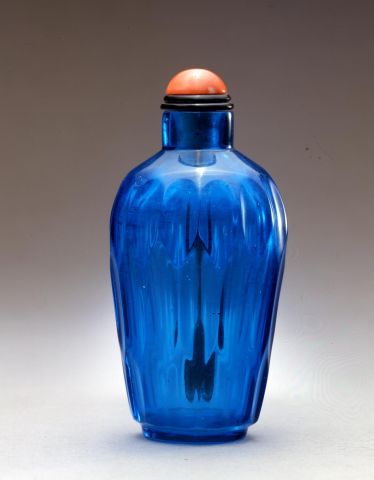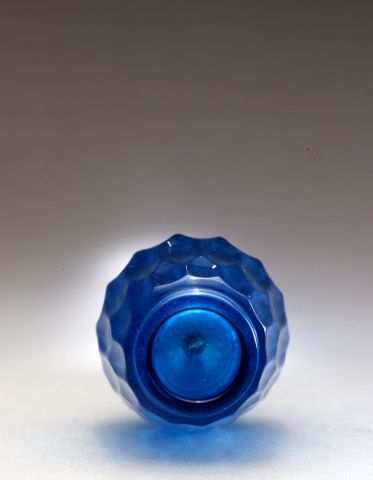

Bottle ID: 00094
BLUE COBALT, W/MOLDED BANDS OF 'HONEYCOMB' FACETS
Date: 1740-1770
Height: 62 mm
Glass, transparent cobalt-blue, of cylindrical baluster form with rounded shoulders ascending to a straight neck, and with a circular indented carved footrim, molded overall with horizontal bands of elongated 'honeycomb' facets, the interior with extensive crizzling.
Imperial, attributed to the Palace Workshops, Beijing.
Similar Examples:
Crane Collection nos. 224 and 265.
Hall, Robert. Chinese Snuff Bottles II, 1998, p. 98, no. 78.
Sotheby's, New York, September 17, 1996, lot 5, Collection of Bernice Straus Hasterlik.
Provenance:
Clare Lawrence Ltd.
Sotheby's, London, June 7th, 1990, lot 111
Exhibited:
Annual Convention ICSBS Toronto, October 2007
For many years "experts" have been making attributions relating to glass, both from China and elsewhere, using crizzling as evidence of firstly Imperial production and secondly an early Qing date. The first "culprit" was W. B. Honey who, in a 1937 article in a Burlington Magazine entitled 'Early Chinese Glass', suggested that crizzling was a direct result of the influence of Westerners in the manufacture of glass in the Palace Workshops. Even a fleeting study of published glass from Europe, Asia and America produced from the seventeenth to the early twentieth century shows that crizzling can occur during any time period. The deterioration of the piece occurs when too much alkali is present in the initial batch of glass, becoming evident usually during the year following manufacture onwards. In 1975, the Glass Works at the Corning Museum tested ten examples of crizzled glass from a wide date range and from different sources. These samples included a piece of Ventian colorless glass, circa 1709; a Silesian glass vessel, circa 1710-1730; and a piece of American glass known to have been made in 1971. The results of this study confirmed that crizzling was not confined to one specific workshop or area and that it cannot be used to attribute provenance.
This cobalt-blue glass bottle, however, is not in question on either score. Every characteristic of this piece adds up to a sum that is more than its individual parts. The combination of the form, color and the interior crizzling strongly suggests an eighteenth century date and an attribution to the Palace Workshops.

 English
English 中文
中文